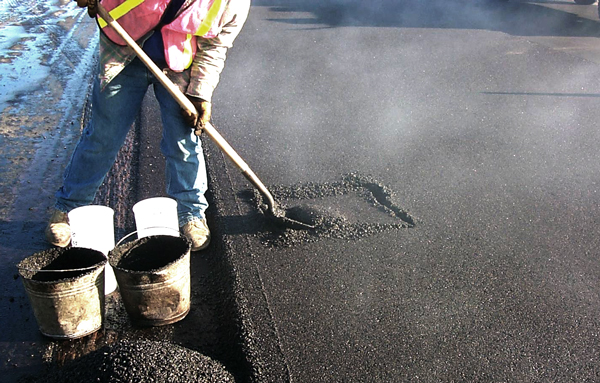Hot Mix Asphalt Paving: Elevating Commercial Parking Lot Requirements
Hot Mix Asphalt Paving: Elevating Commercial Parking Lot Requirements
Blog Article
Opening the Keys of Hot Mix Asphalt Technology
Exploring the midsts of hot mix asphalt innovation reveals a globe where precise formulations and thorough processes merge to form our roads and facilities. The blend of fillers, accumulations, and binders isn't simply a construction job but a calculated orchestration of longevity and efficiency.
Value of Warm Mix Asphalt
Warm Mix Asphalt plays a crucial function in modern infrastructure growth as a result of its durability and cost-effectiveness. As the most commonly utilized leading product for roads, freeways, and car park great deals, Warm Mix Asphalt provides an array of benefits that contribute to its importance in building projects. One crucial advantage is its capability to withstand rush hour tons and rough weather condition conditions, providing a trustworthy and long-lasting surface for transport networks. Additionally, Warm Mix Asphalt is economical in both first building and construction and lasting maintenance, making it a preferred option for several infrastructure jobs.
The longevity of Hot Mix Asphalt comes from its structure, that includes aggregates, binder, and filler materials that are very carefully picked and mixed to meet particular efficiency requirements. This precise combination causes a strong and versatile pavement that can sustain constant use without substantial deterioration. Warm Mix Asphalt is 100% recyclable, further improving its sustainability and ecological advantages. Generally, the relevance of Warm Mix Asphalt in infrastructure growth can not be downplayed, as it proceeds to be a cornerstone of modern building and construction practices.
Elements of Asphalt Mixes
The composition of asphalt blends consists of carefully picked aggregates, binder, and filler products that are critical for achieving specific performance demands. Accumulations are the main component of asphalt blends, giving stamina and stability. The binder, typically bitumen or asphalt cement, holds the aggregates with each other and offers flexibility and toughness to the mix.
The combination and proportion of these elements play a considerable duty in figuring out the top quality and efficiency of the asphalt mix. Designers thoroughly develop the mix to meet certain needs, taking into consideration variables like web traffic volume, environment problems, and sidewalk life expectancy. Correct selection and balancing of accumulations, binder, and fillers are crucial for producing long lasting, lasting asphalt pavements.
Mixing and Manufacturing Methods

As soon as the aggregates are picked, the binder, often asphalt concrete, is included to bind the materials with each other. The binder's high quality and amount significantly influence the mix's versatility, stamina, and resistance to ecological aspects. Furthermore, fillers like moisturized lime or Portland cement may be incorporated to boost particular qualities of the asphalt mix, such as its workability or moisture resistance.
During production, the accumulations and binder are heated, normally in between 250-325 ° F(121-163 ° C ), to facilitate blending and make sure correct finish try this of the accumulations. The blending procedure must be detailed to accomplish a homogeneous mix that promotes the desired efficiency qualities of the asphalt. Numerous techniques, such as set blending or drum blending, are used to attain consistent and high-grade asphalt blends for building projects.
Elements Impacting Asphalt Efficiency
Factors affecting asphalt performance encompass a variety of variables that affect the resilience, long life, and total top quality of asphalt sidewalks. One key factor is the top quality of materials utilized in the asphalt mix. The type and source of aggregates, the binder high quality, and the additives all play Get More Information a substantial function in determining the performance of the asphalt sidewalk. The rank of accumulations is essential as it affects the mix's security, resistance, and workability to rutting and fracturing.

Style considerations, such as sidewalk density and water drainage, are important in making sure the long-term efficiency of the asphalt pavement. By carefully taking into consideration these designers, elements and professionals can enhance asphalt efficiency and enhance the service life of sidewalks.
Lasting Practices in Asphalt Innovation
Additionally, the advancement of warm-mix asphalt (WMA) modern technologies has actually acquired grip in the last few years. WMA permits the manufacturing and placement of asphalt blends at lower temperatures compared to typical hot-mix asphalt, resulting in reduced energy intake and greenhouse gas emissions. The use of permeable asphalt mixes can help like it reduce stormwater overflow problems by enabling water to infiltrate through the pavement and into the ground, advertising all-natural water purification and recharge processes. By executing these lasting techniques, the asphalt sector can add to developing a more resilient and eco pleasant framework network.
Final Thought
To conclude, hot mix asphalt innovation plays an essential function in contemporary framework development because of its toughness and cost-effectiveness. By meticulously stabilizing components, utilizing proper blending techniques, and considering various aspects, designers can create high-quality asphalt mixes that hold up against heavy web traffic tons and harsh weather. Accepting lasting practices, such as using recycled materials and warm-mix modern technologies, further boosts the environmental kindness of asphalt modern technology.
Blending and production strategies in hot mix asphalt innovation entail the precise combination and processing of aggregates, binder, and fillers to develop a long lasting and high-performance asphalt mix.Aspects affecting asphalt performance incorporate a range of variables that influence the longevity, longevity, and overall top quality of asphalt pavements. Sustainable practices in asphalt innovation incorporate different efforts intended at minimizing the ecological influence of asphalt production and paving procedures. By integrating reclaimed asphalt sidewalk (RAP) and recycled asphalt roof shingles (RAS) right into new asphalt blends, the sector can significantly decrease the usage of raw products and power, while also reducing landfill waste.
WMA allows for the production and placement of asphalt blends at lower temperature levels compared to standard hot-mix asphalt, resulting in decreased energy intake and greenhouse gas discharges.
Report this page